Roger Payne is president of the Ocean Alliance. Ocean Alliance, which includes both the Whale Conservation Institute and the Voyage of the Odyssey, is dedicated to the conservation of whales and their ocean environment through research and education.

Monday, 18 Jun 2001
GAROVE ISLAND, Papua New Guinea
This is Roger Payne, writing to you from the Odyssey. Over the next week, I am going to try to give you an idea of what daily life is like aboard our research vessel as we set out across the Bismarck Sea to study sperm whales around New Guinea. I will also describe some of the delights we encounter in the course of this kind of research.
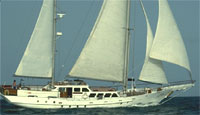
The RV Odyssey.
The Voyage of the Odyssey is a multiyear, collaborative program designed to gather the first-ever coherent set of baseline data on levels of synthetic contaminants throughout the world’s oceans and to measure the effects of these substances on ocean life. It uses predators living at the tops of oceanic food pyramids as indicator species to measure the health of the seas.
Launched in April 2000, Ocean Alliance’s research vessel, Odyssey, will circumnavigate the world between 2000 and 2003, collecting biopsy samples from adult male and female sperm whales and predatory fish in the equatorial zone that will be analyzed by colleagues at Woods Hole Oceanographic Institution.
We are in the middle of a three-and-a-half-week trip and are concentrating our search for sperm whales in an area in which we found them last week. We need to collect more samples from the groups we found and are hoping to put a tag on a sperm whale. This tag can make calibrated recordings for half an hour of the sounds being made by the whale that is carrying it. It is held on by a suction cup that comes off (hopefully) after an hour or so.
When I awoke this morning, we were out at sea, making our way west through mirror-calm seas. But after baking in the sun all day and fighting temperatures above and below decks that were in the 90s, we were unsuccessful in our search for whales. Our days have been hot and the sky blue, with high, wispy clouds mixed with smaller, puffy ones — a stunning skyscape that reflects and blends into the liquid metallic blue of the sea. During much of the day, I was below decks in my cabin, writing material for the web, for my institute, and to my family.
Whenever I went on deck during the course of the day, I found that we were encountering lots of floating detritus, most of it obviously from logging operations. It included trees as big as the Odyssey (God help us if we ever hit such a log at night). Though we were not aware of having hit anything, we must have struck a piece of detritus during the past 24 hours, which took out our bow camera. Because we have a replacement unit, we have decided to take refuge in nearby Garove Island, which boasts a totally protected crater lagoon where we can try to repair the damage.
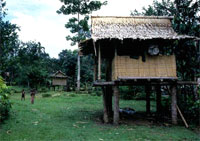
A house on Garove Island.
Photo: Genevieve Johnson, Ocean Alliance.
Garove Island is off the northwest coast of New Britain province, part of the Vitu Island group. As we approached, Genevieve Johnson, who runs our onboard education projects, came to tell me that we would soon be entering the island’s lagoon. She had been there before and knew how beautiful it is. So I went on deck and stood in the yellow light of late afternoon, awestruck, watching an isolated Eden slowly unfolding — a place in which people appear to be living at peace with all aspects of their lives, unaffected by the kinds of forces that bedevil the lives of Westerners like me — as lovely a spot as I’ve ever seen.
The day ended with the Odyssey swinging gently at anchor in the crater — a kind of magical lake closely surrounded by high, near-vertical walls that add mysterious and unearthly echoes to every sound. Large sections of these walls are too steep for trees, but vegetation covers them anyway — vines of the most vivid green I’ve ever beheld, a kind of intense viridescence that looks as if it were giving off its own otherworldly emerald light.
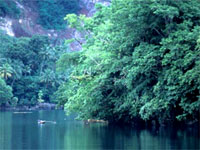
Garove Island crater lagoon — a place lost in time.
Photo: Chris Johnson, Ocean Alliance.
The day is now fading, but through my binoculars I can see a canopy of swifts riding the updrafts high above the crater’s curving rim. About a minute ago, I watched a flying fox make its heavy, hard-flapping way across the lagoon. I have seen it proposed that flying foxes are more closely related to primates than to bats. Whether that is true I cannot judge, but when I think of flying foxes as relatives of mine, I can imagine better what it may entail for such an improbable flier to leave its safe hanging place and strike out across the sea, which is prowling beneath, waiting for a chance to swallow it whole. I’m guessing that such a passage may require greater courage from a cautious primate’s brain than it does from the seemingly incautious brain of the bat clan. If so, are flying foxes brave?
It is now dark and the crew is enjoying their well-earned first night in several of uninterrupted sleep. I just went on deck to listen, alone in the total stillness, to the subtle night sounds that are coming from the crater walls around us.
Flapping, leathery wings occasionally passing overhead.
Fish splashes scattered about.
No lights on shore.
Millions of stars.
The world deep in peace.
So ends this day.
Tuesday, 19 Jun 2001
BISMARCK SEA, Papua New Guinea
This is Roger Payne, writing to you from the Odyssey. Mine is the aft cabin, and each morning when I wake up, the first thing I do is check whether Chris Johnson has left a Zip disk on my floor during the night. It is Chris who shoots and edits video, records sounds, and runs our website, plus the myriad electronic devices aboard Odyssey. Because satellite rates are cheaper at night, he uploads each day’s log and checks for email in the wee hours. When I see a Zip disk on my floor, it means I have email, and this morning, there it was … its magnetic self filled with possibilities. I was out of my bunk in a flash, hoping for news from home. None. Bummer. But I’m spoiled rotten to be so impatient. Nineteenth-century seamen would have killed to have my mail system. They had to wait months, even years, to receive word from home, and their replies only reached their wives or sweethearts after further delays of months or years — not minutes, as we experience today.

Dead pilot whales.
Photo: Iain Kerr, Ocean Alliance.
The message Chris had downloaded was from a friend in Papua New Guinea. It included an article from the Papua New Guinea Post-Courier saying that Sir Hugo Berghuser, a commercial fisherman and former politician, wants whales in the Bismarck Sea killed to save the
fishing industry. According to the article, Sir Hugo thinks pilot whales are robbing fish off fishers’ longlines … something that seems unlikely for a whale species that eats squid. If it is not sharks or even crocodiles that are responsible, it is more likely that false killer whales (pseudorca) are the culprits. Later in the article, Sir Hugo is quoted as saying, “We must kill the whales … there’s too many of them … the whales eat up to 80 percent of the tuna caught by the longliners.” Later, he says that the catch has fallen from 15 tons per month to four.
A longline is a very long fishing line (some are 50 miles long) marked by occasional poles, between which baited hooks are suspended from widely spaced floats. When a fish takes the bait, it fights to exhaustion against the drag of the float and the line, and is collected several hours later when the fisher winches in the line to collect the catch. I would certainly expect sharks, whales, and other large ocean predators to take at least some fish from longlines, but I would be thunderstruck if it turns out that they were the main cause of the kind of major reductions in tuna catch Sir Hugo claims. Such drastic reductions are usually only ever achieved by human overfishing. If fishers here are like fishers elsewhere, a far more likely scenario is that it is they who have caused fish populations to decline sharply and may have affected fish recruitment by overfishing and/or using nets made of smaller mesh that catch smaller fish. The pattern that has emerged from the vast majority of fishery studies in every major fishery from all over the world is that, rather than predators like whales being the problem, it is almost always human fishing practices that cause the big depletions of fish stocks. Which makes sense … after all, whales have occupied these waters for millions of years, maintaining populations that have always allowed plenty of fish to survive and reproduce. The history of human fishing is not as commendable.
But I am willing to be educated and, like any scientist, would like to find out what’s going on. So I hereby offer time aboard my institute’s research vessel for those who may be interested in studying this problem. I suggest that the best approach would be to have our ship, the Odyssey, working alongside a tuna boat (say, Sir Hugo’s) so that together we can find out what’s happening. If Sir Hugo is right and the whales really are causing such mayhem, I am sure others will join him in asking that they be killed. However, there is a clear precedent indicating that far less drastic methods may solve the problem.
I refer here to a study of a group of false killer whales (pseudorca) that had learned to steal fish from longliners in Alaska. Scientists found that the whales hadn’t learned to follow the longline to seek out fish, but only to hang out near the stern of the fishing boat, stripping fish off the hooks when the longline was being retrieved. The payoff came when the study demonstrated that it was the sound of the winch turning on that acted like a dinner bell to the whales. The problem was relieved not by killing the whales, but by mounting the winch on rubber mounts (a standard accessory). I don’t recall whether the people who did this work tried what seems like an obvious strategy: to turn the winch on at odd times so as to attract the whales when no backdown operation was underway and there were no fish in the offing. Such a procedure might eventually have taught the whales to stop associating the sound of the winch with food.
My life is punctuated with having to stop everything I’m doing and engage with suggestions like Sir Hugo’s. Thanks to communication satellites, that kind of interruption doesn’t end just because I’m at sea, thousands of miles from home. So when I read the article containing Sir Hugo’s comments, I went down to my cabin to write him a letter and found myself getting more and more embroiled in trying to explain the consequences of a suggestion that has a far bigger negative side than its proponents obviously realize (else they would suggest resorting to something that has so often been shown to create more problems than it solves and which presents the very real possibility of destroying the very fishery it sets out to protect). When I finally looked up, the sun had set. The day had passed, and I realized I’d spent the whole day typing. The day’s final bummer: While I was stuck below, the others had been getting samples from sperm whales, seven in all, an excellent data set.
So ends this day.
Wednesday, 20 Jun 2001
PAPUA NEW GUINEA
This is Roger Payne, writing to you from the Odyssey. I awoke this morning just before sunrise. The sky was already pink behind silhouetted thunderheads that looked like two-dimensional cardboard cutouts of clouds, the lingering remnants of last night’s violent thunderstorm, which had flashed brilliantly even though the fury they were raining down was at least 100 miles away, presumably over the tropical highlands of New Guinea. The violence of this nightly fireworks spectacle is always shocking, but I have yet to hear any thunder.
I watched as the sky lightened and went through its magical show of pinks and greens and blues and finally (as I was wondering whether I wasn’t hearing a flourish of trumpets) up rose the sun, cutting through all those layers of silken mists like a blowtorch. And so it has continued all day, so hot that, as I sit here typing in my cabin, when the boat rolls or turns to allow a shaft of sunlight to stab down at me through a porthole or the overhead hatch, the heat of it is so intense, so searing, that during those few seconds I feel as if someone had flung open the door of a blast furnace and I was too close. But then the boat rolls or turns and the beam is returned to its sheath once more.
We are now operating in the straits between a group of islands on the western end of New Britain where the sea is rough, because we are at the start of the Southeast monsoon and that wind blows right up the straits. As it squeezes between the high volcanic islands flanking the straits, the wind is compressed and thereby accelerated. To the north is the Bismarck Sea and to the southeast, through the straits, the Solomon Sea. We are seeing our first boats since I have been aboard, and it was at first surprising to learn that there is someone else using these sea lanes in this remote and beautiful part of the world. The names of the islands are wonderful, too: Tolokiwa and Umboi. There are sperm whales here, and we have been working with them in spite of the rough weather.
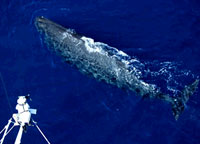
Captain Iain Kerr prepares for a biopsy of a sperm whale.
Photo: Chris Johnson, Ocean Alliance.
When whales are spotted, everyone onboard takes their stations. There is a lookout on scaffolding who sits just ahead of the mizzen mast and another higher up the mast sometimes. The person who will shoot the crossbow carrying the biopsy dart that collects a tiny sample of skin and underlying blubber (that is analyzed later) is on station at the end of the side platform. The helmsman watches the instruments that allow us to follow sperm whales by their sounds; someone is standing by with a clipboard loaded with data forms and a camera to get identification shots of the tail of the whale from which a sample is taken; and Chris Johnson is filming it all as a record of the whales’ reactions (usually nothing that appears to be significant). If a shot is successful, a buoy is thrown into the water next to the floating dart, so we can come back and pick it up later. This is particularly important, though, when the shooter misses, because the whale may resurface almost at once making another try possible, and it may be several minutes before we can break off from that second try and return for the lost dart.
When the boat is brought around and the dart approached, someone goes in to retrieve it. Once it is aboard, a scrap of tissue (about the size of a pencil eraser) is removed from the dart and processed into seven tiny pieces, which are given a variety of treatments so they can be used for the analysis of contaminants (their principal purpose), genetic studies, and for an archive set aside for future analyses. The end of the whole process is the job of labeling the samples with the greatest care, storing them in their proper destinations, and making detailed lists of all of the forms, films, recordings, still shots, and treatments that have anything to do with each sample. It is meticulous work, but that is the difference between carefully and carelessly collected data.
Because the crew members are so familiar with their jobs, this routine runs very smoothly and might even seem a bit monotonous, except that there are always interesting surprises. Today’s came from a pair of large male sperm whales — giants, both of them — who time and again moved off before we got to them. On one occasion, as one of them submerged, just over our acoustic array, it made a series of loud, rapid-fire clicks of a form I have never heard before. Very impressive.
Because the whale making the sounds must have been very close to the hydrophone array, we got an extraordinary recording.
But today I found myself thinking more about Sir Hugo Berghuser, that commercial longline fisher and former politician I mentioned yesterday who “wants whales in the Bismarck Sea killed to save the fishing industry.” I finally realized that the thing that’s so peculiar about his request is that because humans are just one of many predators on tuna, longline fishers the world over are all faced, all of the time, with competition for their catch from sharks, sea lions, seals, dolphins, and other ocean predators (even saltwater crocodiles in rare cases). Even their bait gets stolen (by birds and small fish). So why this sudden call to kill the whales? I suppose it’s because whales have to surface to breathe, and when they do, you can shoot them. But longlining is a fishing technique in which human fishers compete directly with non-human ones. A fisher would have to be hopelessly naive to make the decision to go into longlining without realizing that the natural sequel to a fish taking one of his hooks is that that fish is now accessible to every ocean predator around. And how can a fisher not realize that every time another ocean predator comes across a hooked fish it’s going to try to eat it?
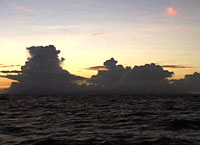
Thunder clouds move in on the Odyssey.
Photo: Roger Payne, Ocean Alliance.
Longlining is a form of fishing in which you leave your catch in the water for several hours, hoping that a larger fish won’t find it before you can get back to retrieve it for yourself. But it’s the name of the game. It’s longlining’s tragic flaw, if you will. It’s what any fisherman decides to face when he becomes a longliner. I feel that anyone who chooses to take up longlining ought to face its realities and get on with it, rather than whining about competition from the ocean’s numerous other tuna predators.
It was with these thoughts in mind that I had my dinner on the aft deck while watching the thunderheads that will light up the sky tonight form in the distance and turn pink in the alpine glow of the setting sun.
And so ends this day.
Thursday, 21 Jun 2001
PAPUA NEW GUINEA
This is Roger Payne, writing to you from aboard the Odyssey. We have been experiencing multiple problems with the Odyssey‘s electrical system and at any moment could lose 90 percent of our power. But we’re well-prepared, and all of life’s basic needs would still be provided for. It’s just that we would have less padding between us and genuine discomfort. Events like this are normal on boats. One expects that all of the problems that can occur will occur, eventually, on any boat. They are not really avoidable. Given our modest budget, Captains Iain Kerr and Bob Wallace have chosen the spares to put onboard wisely and our preparedness has been good. And being prepared is the name of the game.
It’s just that all boats have problems, particularly when they have been banging around the open ocean for 15 months, as Odyssey has. But when it finally arrives, any significant problem, no matter how well you may have anticipated it, always disrupts one’s plans.
Both generators have recently been overhauled, and Bob takes loving care of them always. But generators often fool you in the end. And when they do, what a chain reaction they can set off! I say “chain reaction” because when one thing goes wrong, it tends to trigger other problems. However, chain reactions can also be valuable learning experiences because they teach how vulnerable we humans are at sea.
In our case, it all started with the main generator going out. Josh and Rodrigo investigated: relief. It wasn’t the generator, just its water pump (used to pump the water that cools the generator). It’s a small thing for which we normally carry a spare. However, there are usually two main generators aboard Odyssey. But just now the second one is in Madang, being repaired after it ate the spare water pump. Now we get to see how dependent on electricity the Odyssey really is. We need the generator to cool our fresh food and vegetables, as the main power source to enable us to receive communications from and send them to the rest of the world, to desalinate the water we drink, and to pump the bilges. At present, we have plenty of water and plenty of dry and canned food, we can cook (the main stove is propane, only the microwave needs power), and we can always sail. We also have EPIRBs (Emergency Position Indicating Radio Beacons) and other battery-operated radios with which to call for help, should we need it.
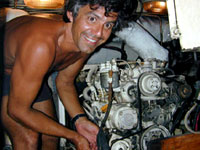
In the engine room, Rodrigo Olen repairs the generator.
Photo: Chris Johnson, Ocean Alliance.
But what about the chain reaction effect? Well here’s an example: Having no generator means that I can’t type at my computer during the late afternoon because the air conditioning is powered by the generator and when it’s off, the temperature below decks soars, and I perspire so much my hands get moist and get my computer wet, which starts to shock me, so I have to stop typing.
Here’s another example: Our service bank of batteries (which we use all the time to run computers and other equipment) are due for replacement with the next haul out. But with the additional pressure being put on the service bank alternator to charge them from the main engine, that alternator stopped charging (for reasons still obscure to all of our resident experts, though I have confidence that they will soon discover them).
News Flash: Josh just solved the problem as I typed.
Another example: It’s getting hard to breathe onboard. That’s because there is something else for which the generator is needed. The sump tank holds sewage until the boat is far enough out to sea to pump it overboard. The sewage pump is powered by the generator, and the sump tank currently happens to be fairly full. When the level in the tank gets close to the top, the aft end of the boat starts to fill with the unpleasant odor of sewage. Pumping out the tank cures the problem, but we can’t do it, of course, until the water pump on the generator is working. With that problem, we really do suffer.
All in all, if we lose most of our power in the next few days (likely, I’m be
tting), we may be out of touch for several days as we slowly make our way under sail towards Madang. But even that demonstrates the chain reaction effect: for it turns out that there is very little wind in these waters. So it could be a longish trip.
All this because we are minus a water pump so small it would fit comfortably in your pocket. But we’ll be fine. In the above litany, I have not bothered to enumerate a bunch of ways in which we can shift batteries around to solve problems, should they arise. It’s just that we may be in for some extra inconvenience.
But there are also some consolations. For example, the battery bank that is used to start the main engine (and only for that purpose) is charging well from its private alternator. And even if both alternators quit, we still have a small (300-watt) generator to use to charge up batteries and do the most important job onboard.
What is the most important job onboard? It is to keep the freezer that stores the samples we have collected cold. Very cold. If that should fail, we would lose a major portion of our data — the main purpose of this voyage. And that would be a disaster in my view far exceeding any I have referred to previously. It is, in fact, a prospect that gives me sleepless nights.
But now it’s my turn to be pleasantly surprised. Josh just told me that we have a dedicated inverter (sounds like a hard-working missionary) that converts battery power to alternating current, and which, in the event of the failure of all three generators and alternators, would still give us the power needed to run the crucial freezer that holds our samples. I thought we were well-prepared before, but now I realize that thanks to Iain, Josh, Bob, and Rodrigo, we’re better prepared than even I had thought.
After another spectacular sunset, darkness is coming, and I am going to bed in order to enjoy properly that time of day when darkness is appropriate and the millions of stars that lie so fat and languorous in these skies get their turn.
So ends this day.
Friday, 22 Jun 2001
PAPUA NEW GUINEA
This is Roger Payne, writing to you from the Odyssey about one of the most appalling fishing practices now being pursued — shark finning. This is the collection of shark fins to be used to make shark fin soup. Shark finning has become almost unbelievably lucrative owing to the high price shark fins command in cities like Singapore, Taipei, and Hong Kong, where a bowl of shark fin soup can cost $90. Most of the sharks caught in America have reached that market — but just their fins. Most of the bodies were dumped back into the sea.
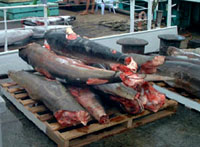
Finned sharks.
Photo: Papua New Guinea National Fisheries
There are many varieties of shark fin soup, but the part of the fin used in making it is just the fibers. They are said not to add flavor, only texture. What gives the soup its flavor are its main ingredients: chicken broth and ham. So the sharks of the world are being destroyed to make ham-flavored chicken soup with a slightly different texture. To get fins for shark fin soup, fishers catch any shark by any means (longlining is the usual technique). Of the roughly 400 shark species known, 100 are caught for shark fin soup, including most of the larger species. So valuable are their fins and so lacking the restrictions that the young of larger species get finned as well.
The combined weight of all of a shark’s fins is only about one-twentieth of its total weight. Getting one ton of fins requires the killing and disposing of 20 tons of shark. It is estimated that somewhere between 40 and 70 million sharks are killed each year worldwide, a take that has caused shark populations everywhere to crash in the past 10 years. Sharks are devastated by heavy fishing because they are slow-growing, late-maturing, and have few young each year (some species only reproduce every other year).
When a shark is caught and boated, its fins are cut off and the now finless animal is tossed overboard. Unable to swim but still alive, the shark must slowly sink to the bottom, where it presumably dies a terrible, lingering death from some unknown cause — infection, starvation, being picked to pieces while still alive by crabs or by other scavengers, and who knows what else. A fisherman in New Jersey reported catching a shark that he figured must have escaped while it was being finned, for it still had its tail fin. The longline hook on which it had presumably been caught earlier and from which it must have been held while its other fins were sliced off, was still in its mouth. This horrific practice is both incredibly cruel and a waste of marine resources.
Because they can be sold for so much, shark fins have been fished out in Asia. Shark meat now sells for $0.20/kg, whereas the fins are worth 850 times as much ($170/kg). In Hong Kong, they can reach up to $500/kg, 2,500 times as much as the meat. Having their fins sliced off while they are still alive must therefore now be the fate of 98 percent of all sharks caught worldwide.
Here in Papua New Guinea, tuna fishers are permitted to take sharks as bycatch, but they often target sharks instead of tuna, since a hold full of shark fins is worth a great deal more than a hold full of tuna. Back in mid-February, after complaints by local fishermen that ships were fishing too close to their reef off Alotau, a Taiwanese-registered mothership along with three longliners were detained and impounded at the main wharf in Port Moresby. The vessels had been licensed to catch tuna, but in just one of them, officials found 50 tons of sharks and only two tons of tuna. While sharks are an acceptable bycatch for tuna fishers, this kind of ratio is ludicrous. The problem comes from the fact that no fixed, legal ratio has been specified to dictate how much bycatch may be taken for how much catch. So fishermen who want to fin sharks go for a tuna license, which gives them the right to catch as many sharks as they like along with the odd tuna. In many cases, sharks constitute more than 90 percent of the “tuna” catch. The impounded vessels are an example in which sharks constituted over 96 percent of the catch — it is really the tuna that is the bycatch in this operation.
It is clear that sharks cannot breed fast enough to keep up with the current demand. As a result, many shark species are now threatened with extinction. Finning has been banned in the Atlantic, but is growing fast in the Pacific. Countries such as the U.S. and Australia have moved to ban the practice. As usual, Japan is dragging its feet. Hopefully, we will all soon realize that these animals cannot possibly reproduce fast enough to keep up with human advances in fishing technology. But will we realize soon enough? And meanwhile, what kind of comment does shark finning make on our species? Of just how much casual cruelty is the human being capable? Where are the limits? Practices like shark finning seem to me to offer further evidence that the missing link between the ape and the human being is man.
And I forgot to mention the final evidence of madness — the rising belief in Asian markets that powdered shark parts have aphrodisiac qualities. How tragic that species such as tigers and sharks should be destroyed because of a baseless hope that they can do something for which there are now proven drugs such as Viagra — drugs which actually do work and which would, I suspect, exceed any shark aphrodisiac user’s wildest fantasies.
It occurs to me that perhaps one of the most useful steps in conserving wildlife right now would be to make Viagra available to the Asian aphrodisiac market. It might require the kind of adjustment in price that was more or less forced on drug companies in order to make AIDS drugs available for developing nations at a cost the users could bear. But by this m
eans, the makers of Viagra might be able to save tigers, sharks, bears, Amazon River dolphins, and a host of other species. Yes, I realize that what we don’t need is an even-faster rate of human population growth. But if anyone out there thinks that a man determined enough to drink a potion of powdered tiger bones is going to give up trying to have sex, well … I suspect they better think again.
Thus ends this day.
Saturday, 23 Jun 2001
MADANG, Papua New GuineaÂ
This is Roger Payne, writing to you from the Odyssey. Last night, while motoring slowly along, the total power outage I had feared finally came. We had stopped the engine to listen for whales but found that when we tried to start it again, the starting batteries were too low to turn the engine over. Realizing that once we managed to restart it, we would not want to take a chance of turning it off again, I decided that this was the last chance we would have to get the silence we needed to record the “Voice from the Sea” piece for our website. So, with the entire boat in pitch darkness, reeling about in its own stately fashion on a sea too calm to sail — and with Josh (bless his heart) lying on the floor of the engine room, struggling with our generator’s broken water pump (so he could start it just long enough to start the main engine) — Chris and I found ourselves completely removed from the entire crisis, leaving its solution in the hands of others as we used the batteries in my computer and those in his recorder to record my piece.
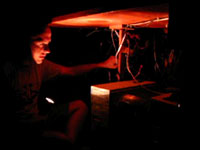
Chris checks computer wiring during the outage.
Photo: Genevieve Johnson, Ocean Alliance.
Success, we thought. But later in the night, when Josh had started the engine by employing a clever Josh-trick that meant he didn’t have to start the ailing generator after all, and when all was up and running again and I had gone to my bunk to sleep, Chris found that the tape we had used to make the recording was faulty. We would have to do it all over again. It is ever thus. How rare is it to hit a tape that was made with a fault? We buy good tapes, and I suspect that bad tapes in our price range are a very rare occurrence.
We arrived in Madang this afternoon, a beautiful, calm day with blue skies, our long trip behind us, our data logs crammed with fresh information, a shelf full of phials with new samples (and more in the freezer), and the satisfaction of having seen our visiting scientist from Denmark, Peter Taglberg Madsen, get the data on sperm whales that he needed to complete his Ph.D. dissertation.
When we first arrived in Madang, Josh went to see if our other dingy and our other generator had been repaired. The answer from the boat yard was almost “What, are you kidding?” So Josh removed the water pump from our still-defunct other generator, brought it back to the Odyssey, and installed it. The sick have been healed, the broken mended, and the generator aboard the Odyssey works. The air conditioner works; in fact, everything is working. So now I sit in my cabin with its temperature at 71 degrees Fahrenheit, while outside in Madang it is a stifling 90 degrees. Electrical power performs miracles. I am glad to have it back in our lives.
We are now lying calmly at anchor in Madang harbor, the end of nearly a month at sea, the end of nearly constant motion, which leaves me feeling that something is missing — and then I realize that it is the discomfort of fighting the boat all the time that is missing, though once I am back in Vermont, I know I shall miss the constant motion of the sea in my life. The day after tomorrow I will start my 40-hour flight home.
Madang is a lovely town where many of the trees are festooned with flying foxes, hanging in clusters like ripe fruit from the upper branches of their roosting trees. During the day, they appear to fan themselves gently with their wings. It is done in several ways and seems to be performed most by those that find themselves hanging in the sun. One technique is to unfurl a wing and, while holding it open in front of their bodies (like a waiter standing by for your order with a towel over his arm), move that wing slowly in and out. Or, they open one wing fully and stretch it down, until it extends well below their heads. Then, while keeping it fully extended, they tremble it and wave it about a bit before slowly — almost reluctantly — refurling it.

Flying foxes.
Photo: Chris Johnson, Ocean Alliance.
At sunset, the flying foxes all leave their Madang roosts, and many of them set out across a short stretch of sea towards the surrounding countryside, where they presumably search for the fruit trees and large flowers on which they feed. As they are crossing the water near us by the thousands, we occasionally see one drop down to the surface and touch it with its mouth, appearing to drink. Back on 9 April, in one of her logs, Gen Johnson postulated that maybe they did this as a means of getting the minerals they need. Since it is done by so very few of the thousands of bats passing overhead, it seems equally plausible to me that the drinkers may simply be inexperienced animals who have mistaken this almost landlocked bay (it looks very unlike the open sea) for a body of freshwater. If so, how many times do they have to make such a mistake before they learn? Judging from the thousands that are not doing it, they learn fast.
This is Roger Payne, signing off. So ends this week.

